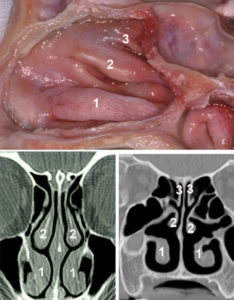Home / Nose Sinuses / Nasal Turbinates
Nasal Turbinates
Call +65 8125 3580
for 24 by 7 appointment
What are nasal turbinates?

Located on the side wall (lateral walls) of the nasal cavity are three bony projections that are lined by nasal mucosa. The lower most of these is called the Inferior Turbinate (1). It is also the largest. The middle of the three is the Middle Turbinate (2). The uppermost of the three turbinates is called the Superior Turbinate (3). In some cases a fourth turbinate may be present. This is called the Supreme Turbinate. The turbinates increase the surface area of the nasal cavity. One of the functions of the nose is to warm and humidify the air that we breathe. No matter what the external temperature is, by the time the air that we breathe, reaches the back part of the nose, it warmed to body temperature. Considering that it takes a fraction of a micro-second to do that it is quite a feat especially when you are in a cold country. It is for this reason that the inferior turbinate has a very profuse blood supply. The blood supply though the inferior turbinate is not the same (equal) on both sides. It always varies. One side of the nose will have more blood flowing through the inferior turbinate than the other side. And it takes turns to do just that. After a period which can vary from 20 minutes o 2 hours the side with more blood supply will shift to the other side. This behaviour of the blood flow through the inferior turbinates is called the NASAL CYCLE. The side with more blood supply will appear slightly blocked as compared to the side with less blood supply. It is for this reason some patients complains of nasal blockage that keeps shifting from one side to the other. The inferior turbinate also contains cells that are involved in allergies, the MAST cells. These cells secrete histamine when they come into contact with the allergens. Histamine being a potent vasodilator will cause the turbinates to swell up. Persistent and prolonged allergies mat lead to the inferior turbinates becoming very swollen and enlarged. This enlarged inferior turbinate may be mistaken for a polyp. Enlarged or hypertrophied inferior turbinates are one of the commonest causes of nasal obstruction.
